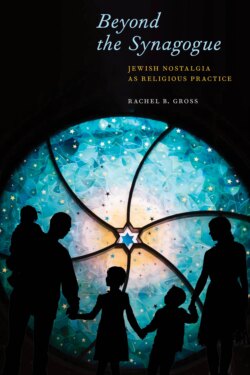Читать книгу Beyond the Synagogue - Rachel B. Gross - Страница 14
На сайте Литреса книга снята с продажи.
1 How Do You Solve a Problem like Nostalgia?
ОглавлениеI do not want anything to happen in Jewish history without it happening to me.
—Elie Wiesel, quoted in Arthur Kurzweil, From Generation to Generation: How to Trace Your Jewish Genealogy and Family History (San Francisco: Jossey-Bass, 2004)
Tiny replicas of the façade of the Jewish Museum of Florida appear throughout the museum. Located in Miami Beach’s South Beach neighborhood, the institution is housed in two former synagogue buildings. The museum’s main entrance is the front of a 1936 synagogue building designed by the well-known Floridian Art Deco architect Henry Hohauser.1 In the museum’s gift shop, located by the front entrance, one may purchase Jewish ritual objects—tzedakah (charity) boxes and mezuzah cases (ritual objects affixed to doorframes)—in the shape of the Hohauser building with which to decorate one’s home or give as a gift.2 In an amusingly self-referential gesture, mezuzahs with the Hohauser façade hang on the internal doorways of the passageway between the two buildings. As they pass between museum spaces, tourists can admire the image of the building even as they stand within it. More traditionally minded Jewish visitors might ritually touch a museum-shaped mezuzah and kiss their fingers as they walk within the museum.
Such hollow, resin miniatures of synagogue buildings are ubiquitous in Jewish gift shops and on websites of Judaica retailers. One can buy replicas of the grand synagogues of Europe, the landmarks of ancient Israel, and American synagogues. They are the kind of tchotchke that might be easily dismissed as an inconsequential item of Jewish culture, not significantly representative of Jews’ beliefs, values, and practices. Alternatively, they might be understood as religious because of their traditional forms, as ritual objects fulfilling the religious mitzvot of giving charity and hanging mezuzahs. But these miniatures also should be understood as religious objects for another reason: They encourage the American Jewish mitzvah of longing for an imagined communal Eastern European Jewish immigration history.
Figure 1.1. Mezuzah depicting the façade of the Jewish Museum of Florida. Photo by author, 2012.
“I would like others to believe as I do—that it is a mitzvah for each of us, in our own unique way, to do what we can to honor our Jewish ancestors—to learn about, preserve, and perpetuate our memories of them and the world in which they lived,” Jewish genealogist Steven Lasky wrote in a cover story for Dorot: The Journal of the Jewish Genealogical Society in 2007.3 Drawing on the past for affective meaning in the present, the mitzvah of nostalgia is both praiseworthy and something American Jews must do. American Jewish nostalgia articulates shared narratives of the past and honors ancestors, creating community in the present and passing on certain sentiments, affections, and values to the next generation. Understanding nostalgia as a mitzvah complicates simplistic, if common, divisions between “religious” and “secular” Jews and between religious and secular Jewish activities. If nostalgia is a mitzvah, a reexamination of American Jewish religion is necessary.
